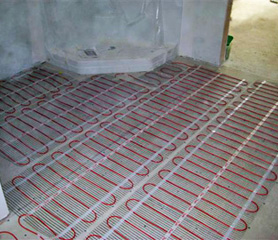

If your slab is below-grade, it is probably 50-60 degrees.

#ELECTRIC RADIANT FLOOR HEATING HOW TO#
(All radiant heating flooring vendors will provide you a plan for how to lay out the radiant wire if you first give them a drawing of the room).

Crossed wires create an unsafe condition and will likely cause the mats to overheat when they are operated. For instance, all electric radiant heating systems require that the heating wires never cross.

However, the real comparison needs to consider the different ways these two systems are used. Operating costs: The cost of electricity in America varies between 3 cents/kWh up to 18 cents per kWh, therefore, the cost of generating 1,000 BTU with a hydronic system may sometimes be lower than the cost of generating 1,000 BTU with an electric system.With electric systems an underground fault detector can find the exact location of the break and after breaking just one or two tiles it is easier to splice the electric cable and replace the few tiles removed. If a hydronic installation is faulty, it is difficult to find a leak and the system is difficult to repair. Electric heating systems have no moving parts and require no maintenance. Maintenance and repairs: Hydronic systems need to circulate water continuously and they use valves and manifolds, which are prone to sedimentation, mechanical problems and maintenance issues.In very large jobs (complete home in new construction), the hydronic radiant floor heating systems will often be less expensive to install. Cost of Installation: In remodeling jobs or in select rooms of a new construction hydronic systems will cost more to install.They are controlled by a timer and a thermostat and in most cases, the homeowners will preset ON-OFF cycles to provide heat only WHEN he/she needs it and WHERE he/she needs it (selecting rooms and heating from your feet up). They will heat the floor in 30 to 60 minutes under tile. Energy Saving: The electric heating mats are placed above the sub-floor, just under the flooring material.Therefore, they are left ON for many months and consume energy during a longer period of time. This is so deep into the floor that it usually takes 4 to 7 hours to heat up when they are first turned ON. Time to heat up: Hydronic systems are placed 1.5" or 2" into a cement slab.Thin electric systems will elevate the floor by only 1/8". The hydronic floor heating system elevates the floor by a couple of inches, which can be a problem in many remodeling jobs. One difference is the floor elevation involved.What are the Advantages of Electric over Hydronic Floor Heating?


 0 kommentar(er)
0 kommentar(er)
